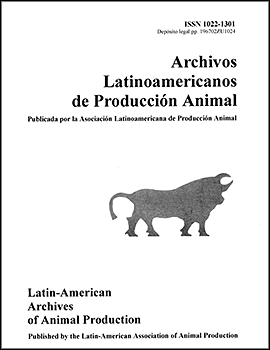
|
Archivos Latinoamericanos de Produccion Animal
Asociacion Latinoamericana de Produccion Animal
ISSN: 1022-1301
EISSN: 1022-1301
Vol. 14, No. 3, 2006, pp. 95-104
|
 Bioline Code: la06018
Bioline Code: la06018
Full paper language: Spanish
Document type: Research Article
Document available free of charge
|
|
|
Archivos Latinoamericanos de Produccion Animal, Vol. 14, No. 3, 2006, pp. 95-104
| en |
Silvopastoral system in the dry tropics of Mexico
J. M. Palma
Abstract
The objective of this review is to report some experiences obtained in the study of trees and their contribution to silvipastoral systems (SPS) in the dry tropics of Mexico. The importance of native arboreal vegetation is emphasized including both leguminous and non-leguminous species, focusing principally on nutritional characteristics, both of the foliage and fruit; also several SPS are described. Included are results obtained in the management of coconut groves in the coastal region of Colima state, of pastures with other trees present, of protein banks based on Leucaena leucocephala, of live fences, and of some forage mixtures-principally those including Gliricidia sepium. This experience occurs within the context of a situation in which a change of attitude is needed both on the part of producers and of related institutions, since in spite of the interest shown in supporting the development of SPS and the demonstrated potential of a diversity of trees, the economic pressure for immediate results has had a negative effect on the sustainment of this type of technology over time. Therefore, it is imperative to foster an attitude favorable to the conservation and multiplication of these species, especially in environments threatened by deforestation and soil erosion.
Keywords
agroforestry, trees, livestock, tropics..
|
| |
| es |
Los sistemas silvopastoriles en el trópico seco Mexicano
J. M. Palma
Resumen
El presente trabajo tiene por objetivo mostrar diferentes experiencias desarrolladas en el estudio de los árboles y su aportación para el desarrollo de sistemas silvopastoriles (SSP) en el trópico seco de México. Se enfatiza la importancia de la vegetación arbórea nativa, tanto de especies leguminosas como no leguminosas, en donde se destacan principalmente características de tipo nutricional, tanto del follaje como de los frutos, así como la descripción de algunos SSP. Se describen los resultados obtenidos en el manejo del cocotero en la región costera del estado de Colima, la presencia de árboles en potreros, así como la experiencia con el manejo de los bancos de proteína basados en Leucaena leucocephala, la utilización de cercas vivas y algunas asociaciones forrajeras principalmente con Gliricidia sepium. Esta experiencia se contextualiza en la necesidad de modificar la actitud tanto de los productores como de las instituciones relacionadas con el sector, pues a pesar del interés mostrado y apoyo para fomentar los SSP, así como del potencial demostrado por la diversidad arbórea, la necesidad económica de resultados inmediatos produce un efecto negativo para mantener en el tiempo este tipo de tecnología. Por lo tanto es necesario generar una cultura para la conservación y multiplicación de estas especies, sobre todo en ambientes en donde la deforestación y la erosión del suelo son una amenaza.
Palabras-clave
agroforestería, árboles, ganado, trópico.
|
| |
© Copyright 2006 - ALPA. Arch. Latinoam. Prod. Anim.
Alternative site location: http://www.alpa.org.ve/ojs/index.php
|
|
